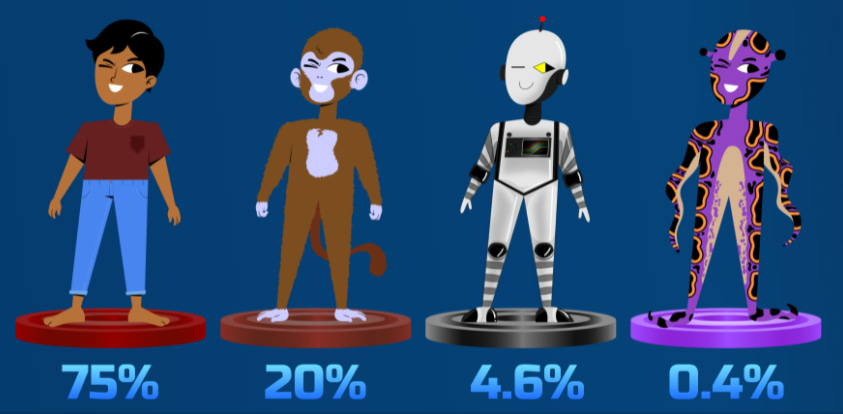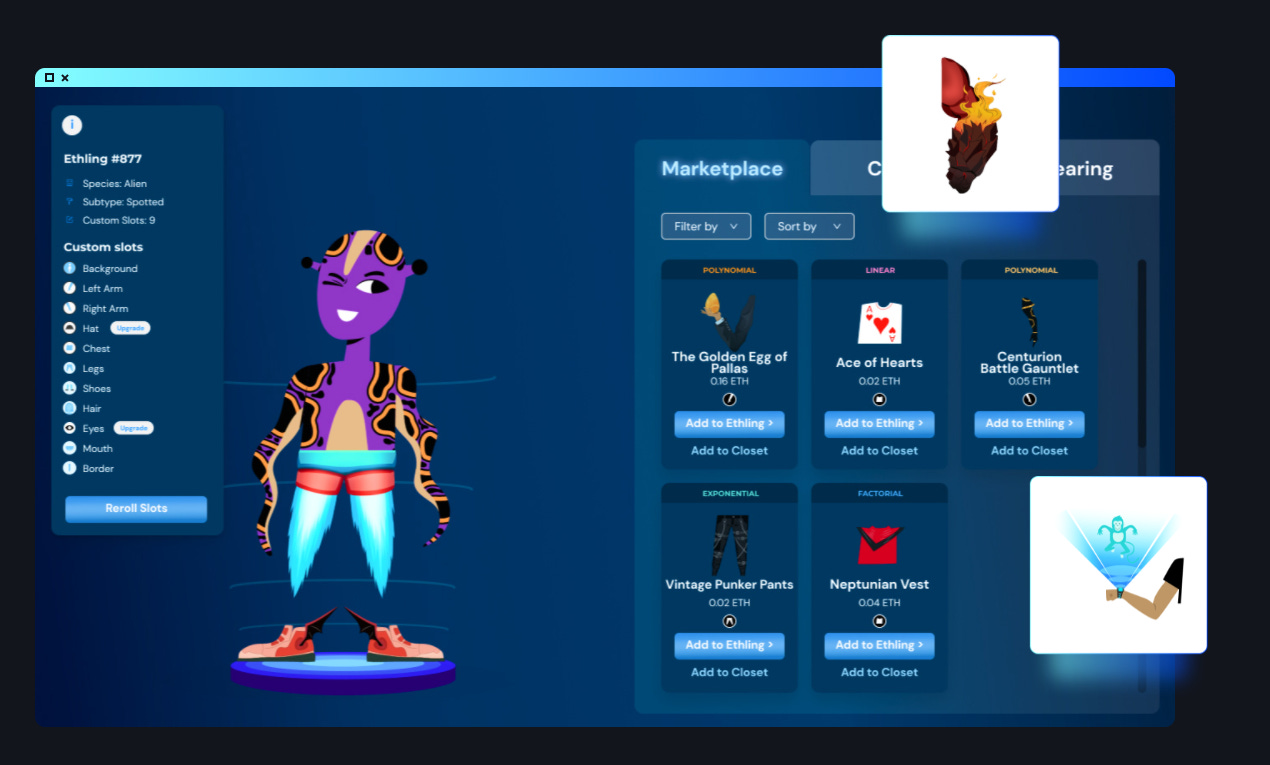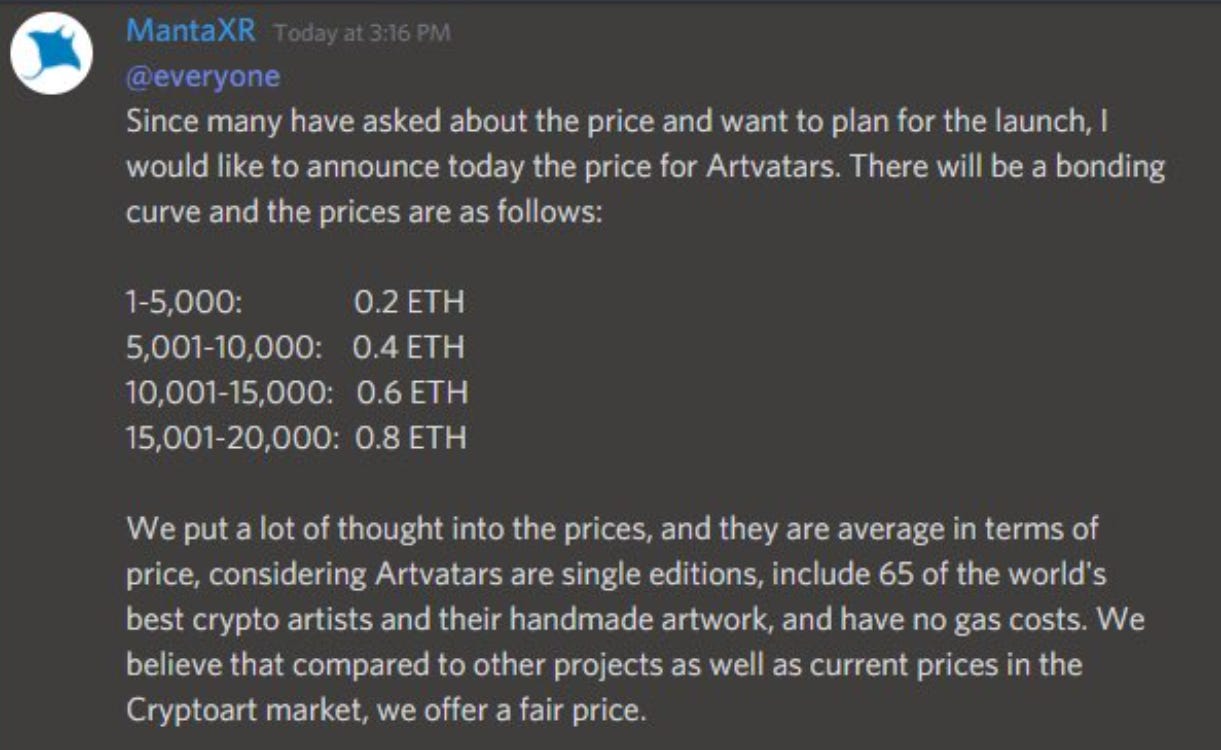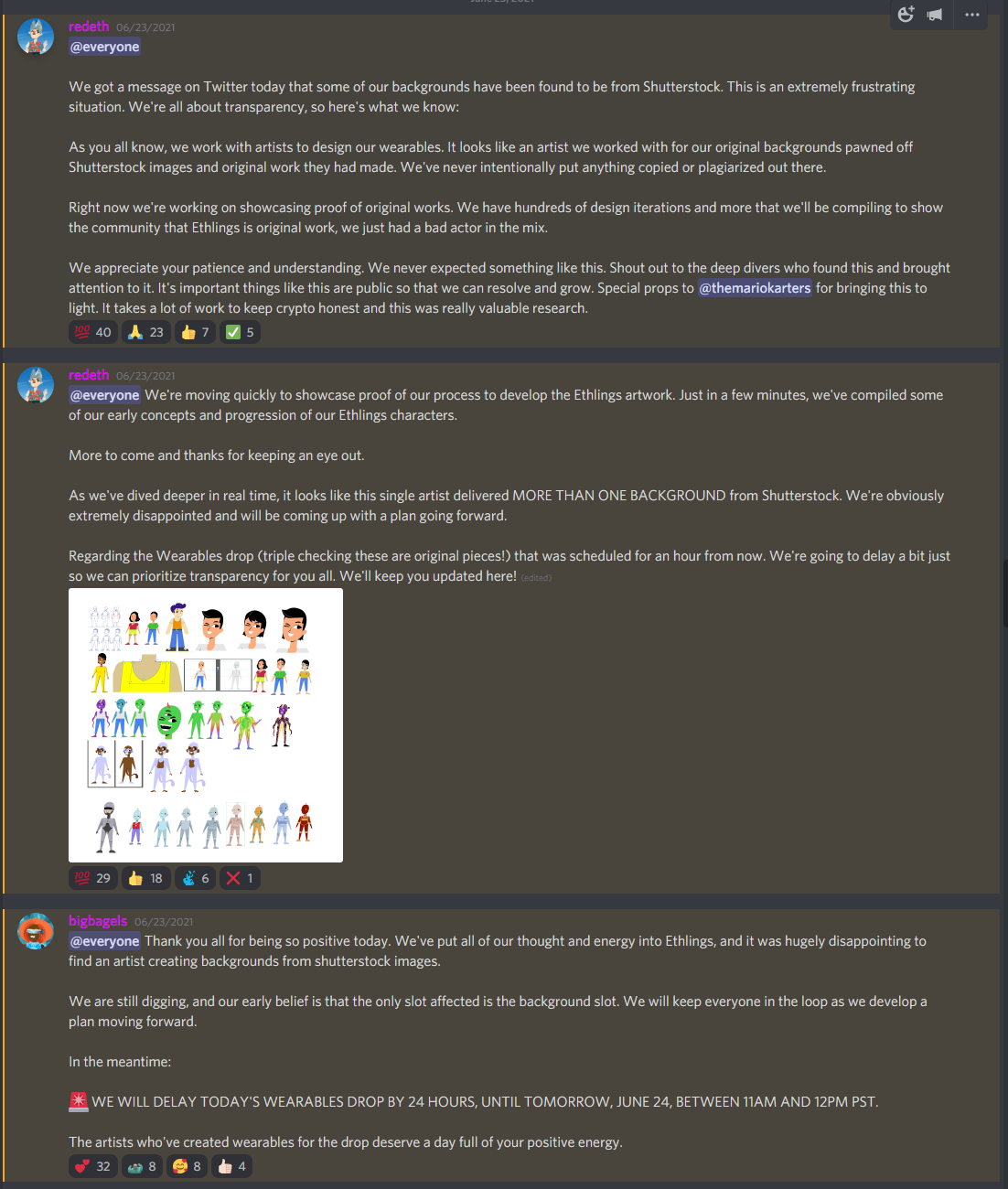With so many new NFT projects launching on a daily basis it can be easy to get swept up in the hype and overlook some of the “older” projects. I use quotation marks because Ethlings is only a few months old. Yes a few months in NFT time feels like years but there are other, much older projects which I would also like to cover in depth at some point: Hashmasks, Avastars, Mooncats - to name a few. But today it is about Ethlings for a couple of reasons:
They had some exciting stuff happen this week so the timing seems appropriate
More importantly, for me, I have a lot going on right now between working on my upcoming educational platform and community Zenacademy, my upcoming podcast with my friend Jaime - Two Bored Apes, my daily stats, my own NFT investing, and too many other things. So I am selfishly choosing a project I already know a lot about and have followed since the beginning rather than something older which requires more research from me.
I think Ethlings is a project that many dismissed immediately and haven’t given another look, and that many new to the space may not have even heard of. Let’s dig into why it was dismissed by many, why it has struggled to find the same level of success as many other avatar projects, and why it might deserve another look.
What are Ethlings?
There’s a lot to break down for this project and before we get into the why or the how, we first need to look at the what. From their website:
Ethlings are a first-of-their-kind collection of NFTs that can be customized on the blockchain. An Ethling is a 1/1 ERC-721 token. When its minted it's given a serial number, a species, a subtype, and an assortment of up to 13 slots that can be customized. Some traits are rarer than others and having an Ethling with a rare species / subtype combination with a lot of customizable slots is hard to come by.
Basically, an Ethling is an NFT. It’s a non-fungible token. For the tech heads it uses the ERC-721 standard which is what most people are thinking of when they think of an NFT. Let’s start with that. It’s just like many of the other NFT avatar projects in that there are different types of Ethlings with different levels of rarity:
This might be where some people tune out because they “don’t like the art”. That’s fine, but give me and Ethlings the benefit of the doubt and make it to the end of this Newsletter at least because there have been some big changes on the art front.
In addition to the type of Ethling you got based on the rarity percentages above, each Ethling also has 13 ‘slots’ for customization. We’ll get into the details of this a bit more shortly but essentially each slot allows for a different way to customize your Ethling - for example there’s a ‘hat’ slot which allows you to, wait for it, put different hats on your Ethling. There’s a ‘background’ slot which allows you to change the background. And so on - 13 slots in total. At the time of minting, each slot had a chance to be ‘enabled’ or ‘disabled’. If it was disabled, your Ethling wasn’t able to customize that slot. Clearly the more slots enabled = the better.
So now that we know what an Ethling is, let’s look at what else is going on with this project. In order to customize your Ethling using the aforementioned slots, there is another type of token called wearables. These are fungible tokens (aka not NFTs, strictly speaking they use the ERC-1155 standard). These act basically the same way as NFTs except that each wearable within a collection is not unique - many people can own the same wearable, and they are interchangeable. Each collection is unique, though. There might be 20 types of hats, all unique, but for each hat there might be 100 editions of it - these editions are the actual tokens that you use and can trade interchangeably.
This is the part that got me excited about this project months ago when they launched, and I still find it very cool. The possibilities with this type of technology are almost endless. At the time of minting whenever someone minted an Ethling they received a random assortment of wearables right off the bat. In order to get additional wearables you can either buy them on Opensea from other people, or, participate in a drop for wearables. The team has been working with a variety of artists who can design their own wearables and release them for sale. The artist gets 95% of the sale proceeds.
There are a lot of technical details regarding how the drops operate and i’ll add a section at the end digging into these a bit. For now I want to talk about a couple of special ‘slots’ that Ethlings have: Aux 1 and Aux 2. These Auxiliary slots were basically designed from inception to allow the team the ability to add whatever they want in the future. For example a commonly thrown around suggestion is to use one of the slots to add Pets to your Ethlings - let’s focus on what they have actually gone ahead and done - adding skins.
Skins
A lot of people immediately dismissed Ethlings because they didn’t like the art. Some people liked it, but I think it’s fair to say that most did not. At the time myself and a few others tried to point out the complexities of the project and the potential for future amazing things such as completely changing the look of your Ethling, but those words seemed to fall on deaf ears and seemed to have little effect on the market. Well I am re-visiting things now that they have released some packs of skins that do completely change the look of things, to make one last ditch effort to highlight the value I think there is in a project with these sorts of capabilities.
The way the new skins work are that each Ethling with an auxiliary 1 slot enabled can equip a skin that changes their look. There are currently two skin ‘packs’ created by two different artists: The Salt and Eloh (real, living, identifiable artists - not anon people somewhere in the world). These were airdropped for free to all Ethling holders, regardless of whether or not their Ethling had aux slot 1 enabled or not. Whether or not this art speaks to you is once again a subjective matter - I personally like it a lot more than the original artwork, and more importantly, it just shows me the diversity and capabilities of the tech behind Ethlings. I imagine that there will be more artists and more skin packs in the future with entirely different looks.
The $ET Token
I said there was a lot to unpack with this project, and here’s another layer to it. In addition to the NFT and the wearables, there is also a regular ERC-20 token aspect. An ERC-20 token is basically a fungible token used on the Ethereum network and you’re probably familiar with them, they are things like $UNI, $SUSHI, $USDC, $AAVE, $LINK, and so on. You can trade them on open centralized exchanges like Binance, and on decentralized exchanges like Uniswap and Sushiswap.
At the time of minting an Ethling, each minter received 1,000 $ET tokens per Ethling minted. In addition to this, there is an additional 1,000 $ET tokens that are earned per Ethling over the first year after launch. So, what’s the point of these tokens? Well there are two use cases. Remember how above we talked about Ethlings having certain wearable slots locked or unlocked? You can use $ET tokens to ‘re-roll’ your Ethling to change the number of slots it has, or you can use the $ET tokens to outright purchase/unlock a new slot.
You can read more about how this works specifically on their website. Suffice to say there is some value in the $ET token, because there is some value attributed to having more slots or certain slots unlocked. The exact value is determined by the open market. Currently 1,000 $ET tokens are worth about 0.02 ETH, and you can buy/sell these tokens on Sushiswap.
Wearable Drops
I said I would add a part touching on the mechanics behind how the drops work for new wearables, and it requires it’s own section because it is a bit complicated (like many parts of this project).
The way wearables are sold are using a system called a SCARCE bonding curve. They invented this system. There has been a lot of bad rep given to bonding curves in the NFT space, and that is largely due to the fact that most people misundertand what a bonding curve actually is, and generally conflate a bonding curve with a price ramp as being the same things.
A price ramp is when the mint price of an NFT increases as the number minted increases. Here is an example of a project that used this type of price ramp (and initially called it a bonding curve - I do believe they later removed the phrase and called it a price ramp or something instead):
As you can see the price increases as the number minted increases. These basically never work (and did not work in the case of Artvatars) because most people balk at the thought of paying 0.8 ETH for something that someone else paid 0.2 ETH for just because they were earlier to mint. These ramps are designed to reward the early adopters and work by creating FOMO (hence why many call these ‘FOMO ramps’), but once the early prices are taken up very few people are actually willing to mint. This ends up, ironically, hurting those early adopters because they are now stuck with an NFT in a project that is struggling to sell out.
A real bonding curve is different. A real bonding curve involves a mechanic where every purchase increases the price, but allows anyone who purchased to sell their NFT back to the curve, reducing the price. This creates a real-time supply and demand price discovery system, and is quite brilliant.
Circling back to Ethlings, they took the idea of a bonding curve and built on it. Here’s how they explain it on their website. At this point I would like to say that I think Ethlings has clearly suffered from too smart for their own good syndrome, and while many of the mechanics they have invented and introduced are brilliant, there’s something to be said for keeping it simple, stupid.
SCARCE stands for (Scheduled Close And Release of Cumulative Earnings). Here's how it works:
1. A unique NFT called an Original is minted for a piece of artwork. In the case of Ethlings, this would be an Original representing a Wearable.
2. Users print and burn on the bonding curve with 93% of the print price going to the reserve and a 7% fee being withheld.
3. After a predetermined period of time, for example 30 days, the bonding curve expires. Printing and burning are stopped completely. The contract freezes the bonding curve, locking the total supply that will EVER exist for that specific NFT.
4. The owner of the Original can burn it to receive the balance of the reserve and withheld fees. Ethlings takes a 5% fee on these earnings.
Believe it or not there’s actually more complexity to the system, with different wearables having different rarities and the bonding curve prices going up at different rates. I won’t go into that, despite it once again being very cool stuff (imo).
Sooooo how do these wearable drops work?? Yeah I know, I’ve said a lot of words without saying a lot. Here’s the 2 minute answer: When a set of wearables are ready to be released, a drop date and time will be announced. At that time the drop goes live and anyone can purchase a wearable. The first to buy gets to buy at the cheapest price, the second at the next cheapest, and so on. At any point, anyone can sell their wearable back to the curve (realizing some profit), and the price goes back down. At the end of a set period (say, 30 days) the ability to buy and sell to the curve disappears, and the collection is locked. The only way to buy or sell these wearables will now be on a secondary market like OpenSea. The value in holding and not selling a particular wearable now comes from its scarcity.
Controversy regarding stock backgrounds
If you’ve been in the NFT space for a while you might remember that there was some controversy surrounding the original Ethlings artwork a month or two ago (or was it a week or 10 weeks ago? time is weird). Essentially what happened was that it was discovered that one of the original artists that created all or almost all the the backgrounds simply stole a lot of their work from Shutterstock. Obviously this is pretty damning and damaging to the brand, and was a huge oversight by the team in not vetting the artwork properly.
But as I always say, it is usually not the issues that matter, but how a team responds to them that tells the character of a project. The response by the Ethlings team could not have been better. They acted swiftly and owned their mistake. They communicated excellently throughout the whole aftermath of the discovery:
On top of this, they actually turned it around and created a fun event where they got the community involved with finding any of the plagiarized art in return for some nice rewards:
I had to include the controversy in this Letter in the interests of providing a comprehensive overview of the project, but I honestly think it just makes Ethlings look better for how they handled it and not worse for the fact that it occurred in the first place. But everyone can make up their own minds about how egregious their initial error was.
How to buy Ethlings and get involved
So, there is another hurdle and barrier to entry hurting the Ethlings project, and it is a double edged sword. They decided to launch their project on the Matic (Polygon) network in order to avoid gas fees. The way the project works with wearables means it would not be possible to have it on the main Ethereum chain. The upside to this is that when they launched and minted out, nobody lost any money in a gas war. It was one of the smoothest and cleanest drops I have ever participated in, which is no small feat and speaks to the quality of the devs.
This also means that buying and selling Ethlings and wearables on the secondary market involves zero gas too.
The downside to all of this is that in order to get involved with the Ethlings ecosystem (and/or anything on the matic (polygon) network) you must first move funds over to that chain. The specifics and technicalities of what matic (polygon) is and how it works is outside the scope of this Letter, but in laymans terms you can think of it as another blockchain running on top of the Ethereum network. The word people use to describe this is another layer - so it is a second layer network.
In order to use this layer you must first send your funds from the main Ethereum chain over to the second layer, the matic (polygon) chain. You do this by “bridging” it, using a website like this. It’s relatively easy and straight forward, and you do have to pay gas when you move money to and from the polygon network, but once you’re on there, it’s all essentially gas-free.
Once again I won’t go into all the specific details on how this work, but if you are interested in getting involved then I would suggest joining the Ethlings Discord where the community members and leaders are more than happy to help people out and talk them through the process. I know because I was one of them once upon a time - I unfortunately don’t spend as much time in their Discord as I would like to these days, but it will always hold a special place in my heart as one of the first and best communities I have ever been a part of.
Why get involved at all?
I sort of covered this already in the above part, and I don’t generally like to outright suggest people to buy an NFT from any specific project. You should always do your own research, and what I say in my Letters is often one, biased opinion (despite my efforts to try and be subjective). So I am not telling anyone to get involved- but I would urge you to take a look (or another look) at the project, and here are a few reasons why.
For what you get, it is incredibly cheap. There are dozens of new projects launching each week with mint costs higher than what you can buy a floor Ethling for. Most of the new projects are run by teams that have proven nothing, and many of them will fail. For the same price you could get an Ethling (or two).
The team is incredibly talented, and they have proven themselves. In a space full of shoddy teams and incompetent devs, it is refreshing to find a project where the devs know what they’re doing. The amount of thought and effort they put into this project is almost unparalleled, and the fact that they’ve pulled off something so complex is a testament to their abilities. Once again I must say that their downfall is that they’re too smart for their own good and tried to release an incredibly complex product to a market that wasn’t ready for it.
The community is fantastic. I’ve been a part of a lot of NFT communities, and there aren’t as many that are as tight-knit and friendly as the Ethling community. They are incredibly welcoming to newcomers and will take the time to explain how things work and help people step-by-step get involved with the Ethling ecosystem.
This is still just the beginning. They have done a lot already, but with the possibilities to collaborate with artists, there really is no telling what can and will be done with Ethlings in the future. We saw skins as the use for auxiliary slot 1, but there is an auxiliary slot 2 that has the potential to be another game changer. There are metaverse integrations and 3d models being created as we speak and you will soon be able to take your Ethling into the metaverse.
On that last point, let me share a bit of what that might look like.
I get a lot of people asking me every day now how they find out about upcoming projects, and how they can be ‘early’. My new default response is to recommend people to go back and find some of the older projects that haven’t popped off yet, but have had hardworking devs building for a significant amount of time. Some recent examples of projects that followed this path are Blitmaps and Voxies, and to a lessor extent Avastars. I’m sure there are more. I’m not saying Ethlings will be like any of those projects, and they may or may not ‘make it’. But I will say that I minted 20 Ethlings, I sold 2 at some point when I needed liquidity in a pinch, and I am holding the other 18 and have slept well at night with them in my portfolio.
What’s on my radar?
Art Blocks - There are a few projects coming up, and these days I generally try to mint something from every new project. The next one is LeWitt Generator Generator by Mitchell F. Chan. It will be a Dutch Auction style sale with the mint price starting at 0.75 ETH and dropping by 0.1 every 10 minutes until it hits 0.05 or sells out (total 750 mints).
Nice Drips - This one literally only came onto my radar a few hours ago. I haven’t done extensive research but I like the art quite a lot.
I’ll just be honest and leave it there. I just spent a few minutes looking through various drop calendars and places to try and find upcoming stuff that I might be interested in, but honestly, there really isn’t a whole lot on my radar at the moment aside from Art Blocks drops. This sort of echoes the whole sentiment of this letter and has me also looking back at older projects as places where I want to be moving more of my money into.
In the interests of full disclosure, at the time of writing I own 18 Ethlings.
We’re still early.
Disclaimer: The content covered in this newsletter is not to be considered as investment advice. I’m not a financial adviser. These are only my own opinions and ideas. You should always consult with a professional/licensed financial adviser before trading or investing in any cryptocurrency related product.









Sounds like a super fun and customizable project with a intimidating learning curve. I'm in. Great stuff
Sick content Z thank you!!! But man honestly cant press the buy button they are so ugly, not kidding